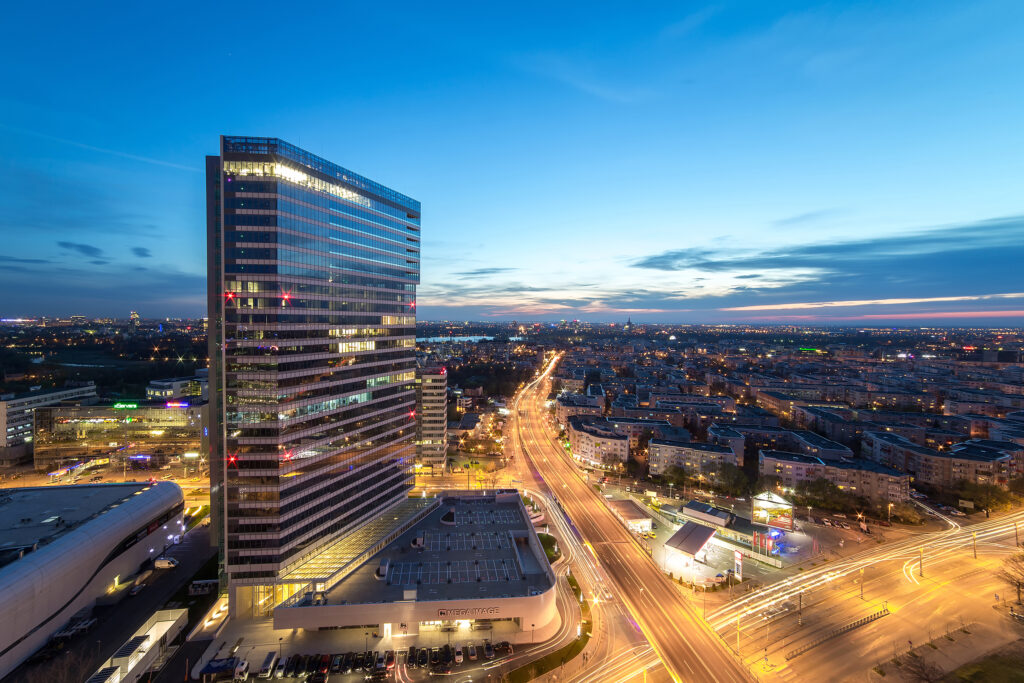WAYPOINT 2025
Bucharest, August 2024: The demand on the Bucharest hotel market in the first half of the year compared to the same period of 2023 had experience an increase of 3%, however, it remained below the 2019 level, according to data from the real estate consulting company Cushman & Wakefield Cushman & Wakefield.
Moving forward, according to Oxford Economics, Bucharest is projected to fully recover and exceed 2019 levels of overnight stays in paid accommodations by 3% by 2025. This growth will be primarily driven by an increase in domestic overnight stays.
Meanwhile, the CEE-6 capitals experienced a 0.6% increase in demand in the first half of 2024 compared to the first half of 2019, while supply grew by a 7.7% over the same period. This positive trend is driven by the impressive recovery of demand in Warsaw, which saw an approximate 17% increase.
Between 2024 and 2026, Bucharest will experience (Bucharest, Warsaw, Prague, Bratislava, Budapest and Sofia) with an approximate 5.8% increase, adding around 2,400 rooms. This growth outpaces the CEE-6 capitals’ average growth of 3.2%.
Several exciting new brands are entering the Bucharest market, including Corinthia, Swissotel, Mondrian, Adagio, Handwritten Collection, and The Crest Collection. Additionally, existing players like Radisson Blu Bucharest will reintroduce renovated rooms in the coming years.
This influx of new supply will help diversify and enhance the hotel offerings in Bucharest’s city center. However, it is expected that the increased competitiveness may temporarily hinder the market performance recovery.
As for the hotel market performance, Bucharest’s RevPAR grew by 9.2% in H1 2024 compared to H1 2023, surpassing both the European and CEE-6 capitals average. This growth was primarily driven by a 5.6% increase in ADR compared to the first half of 2023, despite the VAT increase in January 2023.
Although Bucharest’s ADR in H1 2024 has increased by 15.7% compared to H1 2019, this growth is still below the rate of inflation. This is due to the slow recovery of demand combined with an increase in room supply during the same period.
Occupancy in Bucharest grew by 3.4% in H1 2024 compared to H1 2023, partly driven by various events, such as the Coldplay concert in June. Further occupancy recovery is expected going forward, supported by Romania joining the Air Schengen Area in March 2024.
 Sevda Cadir, Associate Director Cushman & Wakefield: “Bucharest has faced numerous challenges in recent years; however, the city’s hotel performance has shown a healthy recovery, with RevPAR growth in H1 2024 surpassing the European average. While the significant 5.8% increase in supply may temper this growth, the influx of several prestigious brands is set to enhance Bucharest’s hospitality offerings, positioning the city for a bright future in the hotel industry.”
Sevda Cadir, Associate Director Cushman & Wakefield: “Bucharest has faced numerous challenges in recent years; however, the city’s hotel performance has shown a healthy recovery, with RevPAR growth in H1 2024 surpassing the European average. While the significant 5.8% increase in supply may temper this growth, the influx of several prestigious brands is set to enhance Bucharest’s hospitality offerings, positioning the city for a bright future in the hotel industry.”
In YTD June 2024, the RevPAR in the CEE-6 capitals increased by 8.0% compared to H1 2023. This was driven by a 4.2% rise in ADR, with the strongest gains recorded in Prague, Bucharest, and Warsaw. Hotel occupancy reached 67% in H1 2024, 3.6% more than last year, albeit below the pre-pandemic levels across all cites except in Warsaw. Looking ahead, ADR growth is expected to moderate, while occupancy rates are projected to continue their recovery.
Romania experienced a 13% increase in transaction volume compared to H1 2023, reaching a total of EUR 20 million. This growth was mainly driven by the activity in Bucharest, highlighted by the sale of the Ambassador Hotel to Julius Meinl Group. The hotel is due for renovation and will reopen as an upper-upscale aparthotel under The Julius brand.
Currently, according to our market knowledge in Romania, approximately 400 rooms are currently on the market, indicating ongoing opportunities for investors.
Transaction volume in CEE-6 countries (Romania, Poland, Czech Republic, Slovakia, Hungary and Bulgaria) reached €122M in the first half of 2024, 27% less than in H1 2023. This was primarily due to the lack of hotel assets for sale in the CEE region, geopolitical uncertainty, and the high cost of financing. However, this has changed in recent months. Several properties are in various stages of disposition, and this, combined with continued performance growth, improved access to debt, and rising investor interest, is expected to boost volumes in the next 12 months.
After a notable decompression in 2023, yields remained generally stable in the first half of 2024, with values further supported by growing income. With the ECB’s interest rate cut in June and growing liquidity in the debt markets, we expect to see further stabilization in 2024 and gradual yield sharpening for prime assets as we progress into 2025.





